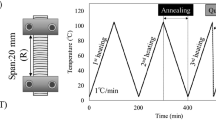Abstract
The radial compression behaviors of acetylated cedar wood were measured in various liquids. The compressive Young’s modulus (E) of acetylated wood was reduced by soaking in water, toluene, and acetone, but it was always greater than that of water-swollen unmodified wood at the same swelling level. The behaviors of acetone-swollen unmodified wood were similar to those of acetylated wood rather than those of water-swollen unmodified wood. These results indicated that the swelling of hydrophobic wood components had a lesser influence on the E of wood than the water-swelling of unmodified hydrophilic components. After large compression (ε > 45%), a part of the strain remained unrecovered because of irreversible mechanical deformation. Since the remaining strain was smaller in the wood specimens indicating greater stress relaxation, it was assumed that the viscoelastic deformation of amorphous matrix components is important for lesser irreversible deformation and effective shape recovery of wood. In contrast with water-swollen unmodified wood, the acetylated wood and acetone-swollen unmodified wood exhibited greater shape recovery despite their relatively higher E. This suggested that the swelling of hydrophobic wood components reduced the viscosity of the matrix rather than its elasticity, resulting in more effective shape recovery with lesser softening.






Similar content being viewed by others
References
Cousins WJ (1976) Young’s modulus of lignin as related to moisture content. Wood Sci Technol 10:9–17
Cousins WJ (1978) Young’s modulus of hemicellulose as related to moisture content. Wood Sci Technol 12:161–167
Gordy W (1939) Spectroscopic comparison of the proton-attracting properties of liquids. Chem Phys 7:93–99
Ishimaru Y, Minase T (1992) Mechanical properties of wood in various stages of swelling I: Mechanical and swelling behavior of wood swollen in various organic liquids. Mokuzai Gakkaishi 38(6):550–555
Kagiya T, Sumida Y, Inoue T (1968) A measure of the electron-donating power and electron-accepting power of liquid organic compounds. Bull Chem Soc Jpn 41:767–773
Minato K, Takazawa R, Ogura K (2003) Dependence of reaction kinetics and physical and mechanical properties on the reaction systems of acetylation II: physical and mechanical properties. J Wood Sci 49:519–524
Obataya E (1999) Suitability of acetylated woods for clarinet reed. J Wood Sci 45:106–112
Obataya E, Gril J (2005) Swelling of acetylated wood I: Swelling in organic liquids. J Wood Sci 51(2):124–129
Obataya E, Ono T, Norimoto T (2000) Vibrational properties of wood along the grain. J Mater Sci 35(12):2993–3001
Obataya E, Minato K, Tomita B (2001) Influence of moisture content on the vibrational properties of hematoxylin-impregnated wood. J Wood Sci 47(4):317–321
Obataya E, Sugiyama M, Tomita B (2002) Dimensional stability of wood acetylated with acetic anhydride solution of glucose pentaacetate. J Wood Sci 48(4):315–319
Obataya E, Furuta Y, Gril J (2003) Dynamic viscoelastic properties of wood acetylated with acetic anhydride solution of glucose pentaacetate. J Wood Sci 49(2):158–165
Ohkoshi M, Kato A (1997) 13 C-NMR analysis of acetyl groups in acetylated wood II: Acetyl groups in lignin. Mokuzai Gakkaishi 43(4):364–369
Ohkoshi M, Kato A, Hayashi N (1997) 13 C-NMR analysis of acetyl groups in acetylated wood I: Acetyl groups in cellulose and hemicellulose. Mokuzai Gakkaishi 43(4):327–336
Rowell RM (1982) Distribution of acetyl groups in southern pine reacted with acetic anhydride. J Wood Sci 15(2):172–182
Rowell RA (1991) Chemical modification of wood. In: Wood and cellulosic chemistry. Marcel Dekker, New York
Rowell RM, Simonsen R, Hess S, Plackett DV, Cronshaw D, Dunningham E (1994) Acetyl distribution in acetylated whole wood and reactivity of isolated cell wall components to acetic anhydride. Wood Fiber Sci 26(1):11–18
Author information
Authors and Affiliations
Corresponding author
Rights and permissions
About this article
Cite this article
Obataya, E., Yamauchi, H. Compression behaviors of acetylated wood in organic liquids. Part I. Compression in equilibrium conditions. Wood Sci Technol 39, 492–501 (2005). https://doi.org/10.1007/s00226-005-0018-9
Received:
Published:
Issue Date:
DOI: https://doi.org/10.1007/s00226-005-0018-9




